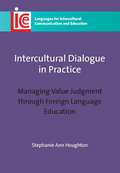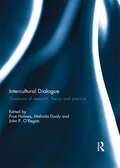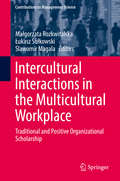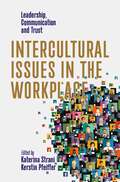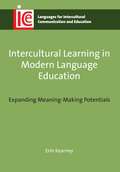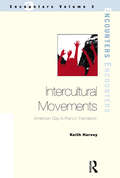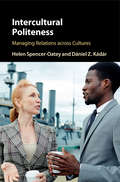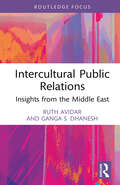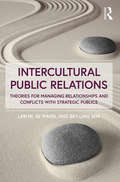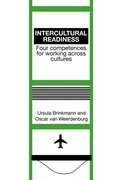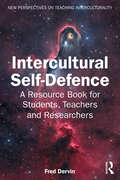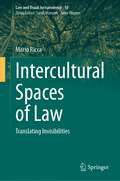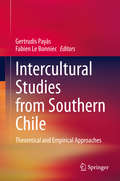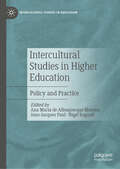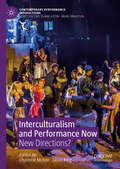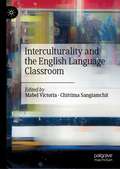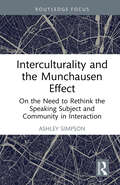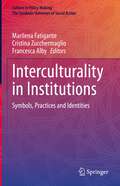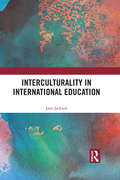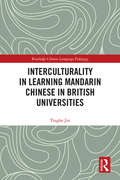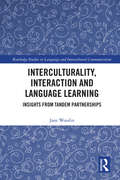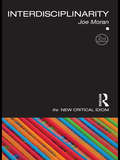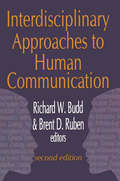- Table View
- List View
Intercultural Dialogue in Practice
by Stephanie Ann HoughtonThe term intercultural dialogue has become a buzzword at policy level, but there is a pressing need to synchronise the terminology of policymakers with that of academics. An overarching aim of this book is to explore the wide-ranging terminology relevant to intercultural dialogue in order to promote clearer consideration of the underlying issues. More specifically, this book reports the findings of a research project conducted in Japan that brought teaching practice to bear upon some of the main conflicting theoretical perspectives on how value judgment should be managed in foreign language education. At the heart of this issue lies the management of prejudice, which is a key dynamic in intercultural dialogue that brings many other factors into play.
Intercultural Dialogue: Questions of research, theory, and practice
by Prue Holmes, Melinda Dooly and John P. O’Regan‘Intercultural dialogue’, as a concept and ideology in the European Union, stimulates a rational 21st century society where people can engage in (intercultural) communication on a global scale, and can do so openly and freely in conditions of security and mutual respect. Intercultural dialogue connotes dialogic communication that is peaceful, reconciliatory, and democratic. Yet the term and its accompanying rhetoric belie the intercultural communicative undercurrents and their manifestations that people encounter in their daily lives. The research-informed chapters in this book, which are situated in international contexts, provide more nuanced understandings, and many even challenge this non-critical ideology by suggesting that the concept of intercultural dialogue is inoperable and problematic under the present conditions of globalisation and migration, where there exists conflict, vulnerability, and instability. The different theoretical perspectives and analyses presented by the authors are a reminder that researchers in the field of intercultural communication require robust and appropriate theories, methods, and pedagogies in order to research these complex conditions and contexts, particularly where different languages and identities are present. The book is also a reminder of how context and power both (re)shape and contest the central tenets of intercultural dialogue—in particular, of who speaks for whom, when, how, and under what circumstances and conditions. This book was originally published as a special issue of Language and Intercultural Communication.
Intercultural Interactions in the Multicultural Workplace
by Małgorzata Rozkwitalska Łukasz Sułkowski Slawomir MagalaThis volume explores the work environment in multinational corporations. To do so, it integrates studies on the organizational sciences, cross-cultural management, positive psychology and sociology within a single comprehensive framework. Twenty-two authors from six countries identify the challenges in multicultural workplaces, the positives of interactions, cultural clashes and their organizational preconditions. They add inter-organizational, institutional and critical perspectives to the analysis within the framework of multinationals and complex, hybrid cultural environments. The book addresses the needs of researchers in the areas of intercultural management, and those of practitioners in international human resource management.
Intercultural Issues in the Workplace: Leadership, Communication and Trust
by Katerina Strani Kerstin PfeifferThis textbook addresses key issues and challenges in contemporary multicultural and multilingual workplaces through the lens of leadership, communication and trust. It draws together contributions from fields including cultural studies, psychology, sociolinguistics, translation and interpreting studies, and business management, making a valuable contribution to the area of language and culture in the workplace. The volume is divided into 5 thematic sections: Intercultural Communication; Cross-cultural Leadership; Economy; Language; and Diversity. It offers a critical analysis on themes that tend to be overlooked in intercultural business and management scholarship, such as multilingualism in the workplace, translation and interpreting in cross-cultural work practices, dignity in the workplace, performing gender in the workplace, and D/deaf people in the workplace. It also revisits themes such as cross-cultural leadership, interculturality and the embedded economy, and managing uncertainty in the context of the contemporary globalized workplace. It then brings everything together in a Cross-Cultural Scenarios chapter at the end, with recommendations for every scenario. Overall, the textbook constitutes an essential resource for honours undergraduate and postgraduate students in these and related fields, as well as academics and practitioners with an interest in globalised workplaces.
Intercultural Language Teaching and Learning (Language Learning And Language Teaching Ser. #33)
by Anthony J. Liddicoat Angela ScarinoThis wide-ranging survey of issues in intercultural language teaching and learning covers everything from core concepts to program evaluation, and advocates a fluid, responsive approach to teaching language that reflects its central role in fostering intercultural understanding. Includes coverage of theoretical issues defining language, culture, and communication, as well as practice-driven issues such as classroom interactions, technologies, programs, and language assessment Examines systematically the components of language teaching: language itself, meaning, culture, learning, communicating, and assessments, and puts them in social and cultural context Features numerous examples throughout, drawn from various languages, international contexts, and frameworks Incorporates a decade of in-depth research and detailed documentation from the authors’ collaborative work with practicing teachers Provides a much-needed addition to the sparse literature on intercultural aspects of language education
Intercultural Learning in Modern Language Education
by Erin KearneyMany educators aim to engage students in deeply meaningful learning in the language classroom, often facing challenges to connect the students with the culture of the language they are learning. This book aims to demonstrate that substantial intercultural learning can and does occur in the modern language classroom, and explores the features of the classroom that support meaningful culture-in-language-learning. The author argues that transformative modern language education is intimately tied to a view of language learning as an engagement in meaning-making activity, or semiotic practice. The empirical evidence presented is analyzed and then linked to both the theorizing of culture-in-language-teaching and to practical concerns of teaching.
Intercultural Movements: American Gay in French Translation
by Keith HarveyHow was American gay liberation received in France between the events of Stonewall and the AIDS crisis? What part did translations of American 'gay fiction' play in this reception? How might the various intercultural movements that characterize the French response to 'American gay' be conceptualized as translational? Intercultural Movements attempts to answer these questions by situating detailed analyses of key textual and paratextual dimensions of selected translations within an understanding of the French fascination in the 1970s with the model of gay emancipation in the United States. Through an examination of the translations of Andrew Holleran's Dancer from the Dance, John Rechy's Rushes and Larry Kramer's Faggots, the book explores the dynamic of attraction, assimilation, transformation and rejection that characterizes French attitudes at the time. In particular, representations of the figure of the 'queen' - of the effeminate homosexual - are identified as particularly sensitive textual zones for understanding French views on homosexual emancipation in the light of American developments. Key figures involved in these debates include translators, academics and activists such as Alain-Emanuel Dreuilhe, Michel Foucault, Guy Hocquenghem, Brice Matthieussent, Philippe Mikriammos and Georges-Michel Sarotte - many of whom lived out the translational pressures of the time through various types of physical (as well as textual) displacement into the foreign space. More broadly, the book envisages using translation and translatedness as the paradigm case for all sorts of intercultural traffic while also intimating the possibility of an intercultural studies predicated upon a vision of cultural spaces as necessarily traversed and constituted by (mis)recognitions of cultural others.
Intercultural Politeness: Managing Relations across Cultures
by Helen Spencer-Oatey Dániel KádárIt is increasingly important in our globalised world for people to successfully manage interpersonal relationships. This is the first book to tackle this vital topic, by taking an interdisciplinary approach to exploring the process of relating across cultures. Drawing together key concepts from politeness theory, intercultural communication, and cross-cultural/intercultural psychology, it provides a robust framework for analysing and understanding intercultural encounters. It explores the ways in which individuals make judgements about others, deal with offence and conflict, maintain smooth relations, and build new relationships. These processes are explained conceptually and illustrated extensively with authentic intercultural examples and empirical data. With accessible explanations and follow-up activities, it will appeal not only to academics working in the areas of intercultural communication, pragmatic theory, conflict research and other related academic disciplines, but also to students of these topics, as well as professionals such as intercultural trainers and those working in the third sector.
Intercultural Public Relations: Insights from the Middle East (Global PR Insights)
by Ruth Avidar Ganga S. DhaneshThis book examines the intricate relationship between culture and public relations within the Middle Eastern context, adopting an interpretive, inductive approach to explore how various cultural dimensions shape the enactment of key public relations concepts. Using the Global Public Relations Framework (GPRF) as a guiding structure, the book analyzes the influence of political, economic, societal, media, activist, and organizational cultures on public relations in Israel and the United Arab Emirates (UAE).The book first focuses on Israel, investigating how cultural factors influence organizational identity and reputation. The book then shifts to the UAE, exploring how cultural dynamics affect organizational listening and engagement among organizations and publics. By examining the dialectical interaction between local and global cultural factors, the book offers a nuanced understanding of how public relations is practiced in these diverse Middle Eastern contexts.This book provides valuable insights for scholars, practitioners, and students interested in global public relations, intercultural communication, and Middle Eastern studies. It highlights the significance of cultural specificity in shaping public relations strategies and practices, offering a unique contribution to the field’s understanding of public relations in non- Western settings.
Intercultural Public Relations: Theories for Managing Relationships and Conflicts with Strategic Publics
by Lan Ni Qi Wang Bey-Ling ShaIntercultural Public Relations: Theories for Managing Relationships and Conflicts with Strategic Publics develops a coherent framework to unify the theories of public relations and intercultural communication, and, within the framework, examines empirical studies of intercultural interactions. This book follows an intercultural approach, which considers how individuals and entities with dissimilar cultural identities interact and negotiate to solve problems and reach mutually satisfying outcomes. This work provides a theory-driven, empirically supported framework that will inform and guide the research and practices of intercultural public relations. Furthermore, it provides numerous levels of analysis and incorporates the use and challenges of social media. The book examines theories and issues in three integrated processes: Identification of publics Relationship management Conflict resolution These areas represent the most critical functions that public relations contributes to organizational effectiveness: scanning the environment, identifying strategic publics, and building long-term, quality relationships with these publics to reduce costs, gain support, and empower the publics themselves. In doing so, the book adopts simultaneously public-centered and organization-centered perspectives. This unique work will serve as an essential reference for students, practitioners, and scholars in today’s global public relations environment.
Intercultural Readiness
by Ursula Brinkmann Oscar Van WeerdenburgDrawing on research from 30,000 individuals and their practical experience as intercultural management consultants, the authors provide insights into the broader landscape of intercultural management through their exploration of 4 competencies: Intercultural Sensitivity, Intercultural Communication, Building Commitment and Managing Uncertainty.
Intercultural Self-Defence: A Resource Book for Students, Teachers and Researchers (New Perspectives on Teaching Interculturality)
by Fred DervinBased on the author’s 25 years of experience in researching and teaching interculturality, Intercultural Self-Defence: A Resource Book for Students, Teachers and Researchers is a compelling exploration of the subtle forces that shape Intercultural Communication Education and Research (ICER).The Resource Book delves into the adversaries lurking within ICER - indoctrination, intellectual inertia and linguistic indifference - and unveils how they can stifle genuine understanding and growth. Each chapter acts as a critical lens, scrutinising the boundaries between education and indoctrination, the stagnation of thought and the perils of linguistic complacency. The author illustrates the impact of these forces on interculturality and the ethical implications they carry. The book contains a series of activities designed to encourage creative self-reflection and fosters a deeper understanding of the interplay between language, power and interculturality. But it is more than a resource: It is a manifesto for continuous learning, active engagement and the pursuit of a more inclusive and dynamic field of intercultural communication education and scholarship.Advocating a vigilant and self-reflexive approach, the book will serve as a critical guide for students, teachers and researchers specialising in intercultural research and education to navigate the complexities of interculturality.
Intercultural Spaces of Law: Translating Invisibilities (Law and Visual Jurisprudence #10)
by Mario RiccaThis book proposes an interdisciplinary methodology for developing an intercultural use of law so as to include cultural differences and their protection within legal discourse; this is based on an analysis of the sensory grammar tacitly included in categorizations. This is achieved by combining the theoretical insights provided by legal theory, anthropology and semiotics with a reading of human rights as translational interfaces among the different cultural spaces in which people live. To support this use of human rights’ semantic and normative potential, a specific cultural-geographic view dubbed ‘legal chorology’ is employed. Its primary purpose is to show the extant continuity between categories and spaces of experience, and more specifically between legal meanings and the spatial dimensions of people’s lives. Through the lens of legal chorology and the intercultural, translational use of human rights, the book provides a methodology that shows how to make space and law reciprocally transformative so as to create an inclusive legal grammar that is equidistant from social cultural differences. The analysis includes: a critical view on opportunities for intercultural secularization; the possibility of construing a legal grammar of quotidian life that leads to an inclusive equidistance from differences rather than an unachievable neutrality or an all-encompassing universal legal ontology; an interdisciplinary methodology for legal intercultural translation; a chorological reading of the relationships between human rights protection and lived spaces; and an intercultural and geo-semiotic examination of a series of legal cases and current issues such as indigenous peoples’ rights and the international protection of sacred places.
Intercultural Studies from Southern Chile: Theoretical and Empirical Approaches
by Gertrudis Payàs Fabien Le BonniecThis book presents a multidisciplinary overview of a little known interethnic conflict in the southernmost part of the Americas: the tensions between the Mapuche indigenous people and the settlers of European descent in the Araucania region, in southern Chile. Politically autonomous during the colonial period, the Mapuche had their land confiscated, their population decimated and the survivors displaced and relocated as marginalized and poor peasants by Chilean white settlers at the end of the nineteenth century, when Araucania was transformed in a multi-ethnic region marked by numerous tensions between the marginalized indigenous population and the dominant Chileans of European descent.This contributed volume presents a collection of papers which delve into some of the intercultural dilemmas posed by these complex interethnic relations. These papers were originally published in Spanish and French and provide a sample of the research activities of the Núcleo de Estudios Interétnicos e Interculturales (NEII) at the Universidad Católica de Temuco, in the capital of Araucania. The NEII research center brings together scholars from different fields: sociocultural anthropology, sociolinguistics, ethno-literature, intercultural education, intercultural philosophy, ethno-history and translation studies to produce innovative research in intercultural and interethnic relations. The chapters in this volume present a sample of this work, focusing on three main topics: The ambivalence between the inclusion and exclusion of indigenous peoples in processes of nation-building.The challenges posed by the incorporation of intercultural practices in the spheres of language, education and justice.The limitations of a functional notion of interculturality based on eurocentric thought and neoliberal economic rationality. Intercultural Studies from Southern Chile: Theoretical and Empirical Approaches will be of interest to anthropologists, linguists, historians, philosophers, educators and a range of other social scientists interested in intercultural and interethnic studies.
Intercultural Studies in Higher Education: Policy and Practice (Intercultural Studies in Education)
by Nigel Bagnall Ana Maria de Albuquerque Moreira Jean-Jacques PaulThis book explores the study of policies and practices in Higher Education by comparing systems, institutions, programs, innovations, results and cultures. In a rapidly changing global and international marketplace, the growth of higher education has occurred within distinct cultural contexts, meaning that change is reflected within local, regional, national and global perspectives. Using a single data methodology across countries and continents, the editors and contributors explore higher education reforms between global and local dimensions, the expansion of access and democratisation, and relevant aspects in the organisation and management of higher education. In doing so, this book arrives at an understanding of higher education at a truly intercultural level, which can lead to a deeper and more holistic understanding of policies and practices in higher education. This innovative book will be of interest and value to students and scholars of higher education across the world as well as the study of interculturality.
Intercultural and Transcultural Awareness in Language Teaching (Elements in Language Teaching)
by Will BakerThe central aim of language teaching is typically to prepare learners to communicate through the language learnt. However, much current language teaching theory and practice is based on a simplistic view of communication that fails to match the multilingual and intercultural reality of the majority of second language (L2) use. This Element examines the relationship between language and culture through an L2 in intercultural and transcultural communication. It puts forward the argument that we need to go beyond communicative competence in language teaching and focus instead on intercultural and transcultural awareness. Implications for pedagogic practice are explored including intercultural and transcultural language education.
Interculturalism and Performance Now: New Directions? (Contemporary Performance Interactions )
by Jason King Charlotte McIvorThis book is the first edited collection to respond to an undeniable resurgence of critical activity around the controversial theoretical term ‘interculturalism’ in theatre and performance studies. Long one of the field’s most vigorously debated concepts, intercultural performance has typically referred to the hybrid mixture of performance forms from different cultures (typically divided along an East-West or North-South axis) and its related practices frequently charged with appropriation, exploitation or ill-founded universalism. New critical approaches since the late 2000s and early 2010s instead reveal a plethora of localized, grassroots, diasporic and historical approaches to the theory and practice of intercultural performance which make available novel critical and political possibilities for performance practitioners and scholars. This collection consolidates and pushes forward reflection on these recent shifts by offering case studies from Asia, Africa, Australasia, Latin America, North America, and Western Europe which debate the possibilities and limitations of this theoretical turn towards a ‘new’ interculturalism.
Interculturality and the English Language Classroom
by Mabel Victoria Chittima SangiamchitThis book examines the concept of interculturality in English Language Teaching (ELT), using examples from diverse international and educational settings to demonstrate different approaches. Increased contact between multilingual speakers from different cultural backgrounds means that linguistic and intercultural competence must be taught hand in hand, and the approaches featured here will: encourage learners to develop intercultural sensitivity and a critical intercultural attitude; mitigate the limitations of textbooks and extend the learning to global issues, intercultural citizenship, and media literacy; show the potential of telecollaboration and popular culture as pedagogical resources; and demonstrate the value of interculturality in English as lingua franca situations and English for Academic Purposes. The chapters feature empirical studies from around the world, and include questions for reflection and recommended reading so that readers can engage more closely with key concepts, compare and adapt the practices most relevant to them. This book contributes to the literature on (inter)cultural pedagogy, English as a lingua franca, language pedagogy, and teacher professional development, and will be an invaluable tool for English language teachers, teacher trainers and educators seeking to enrich their practice. It will also be of interest to students and scholars of Applied Linguistics, especially language education.
Interculturality and the Munchausen Effect: On the Need to Rethink the Speaking Subject and Community in Interaction (Routledge Studies in Language and Intercultural Communication)
by Ashley SimpsonThis book offers a conceptual intervention for Language and Intercultural Communication studies by advocating for a critical interdiscursive approach to research on interculturality. The volume addresses two interrelated theses in research on interculturality; namely that the speaking subject in interaction reproduces the egocentrism and phonocentrism of the Munchausen Effect. In considering the first, the book traces the ways in which interculturality research has historically supposed the ‘speaking subject’—that is, the research participant—as the basis of truth and knowledge, not giving context to the discursive layers or paratexts involved in analyzing the subject’s speech. This notion of the ‘speaking subject’ being taken at face value prompts Simpson’s second interrelated argument on representation and historical conceptualizations of community in interculturality research, whereby, in trying to represent their subjects, researchers often impose a sense of community affiliation onto their subjects and end up negating their subjective identities. The book serves as a conceptual and practical response to calls for epistemological diversity and plurality within Interculturality in proposing an approach that brings epistemology and ontology together.This book will be of interest to scholars in intercultural communication, language education, identity theory, and philosophy of education.
Interculturality in Institutions: Symbols, Practices and Identities (Culture in Policy Making: The Symbolic Universes of Social Action)
by Cristina Zucchermaglio Marilena Fatigante Francesca AlbyThis book provides qualitative analyses of intercultural sense making in a variety of institutional contexts. It relies on the assumption that in an increasingly culturally diverse world, individuals often enter contexts that have communal, historically determined and stable sets of values, norms and expected identities, with little cultural compass to find their bearings in them. The book goes beyond interpreting differences in people’s ethnic or linguistic roots and discusses instead people’s interpretive efforts to navigate different sociocultural situations. The contributors examine such situations in educational, organizational, medical and community settings and look at how participants with different levels of sociocultural competences (such as, migrant patients, migrant adult learners, children) try to cope with institutional constraints and expectations, how they understand symbols, practices and identities in institutional contexts, and how their creative adjustments come to light. This book provides insights from the fields of psychology, education, anthropology and linguistics, and is for a wide readership interested in cultural meaning-making.
Interculturality in International Education
by Jane JacksonThis comprehensive volume provides a state-of-the-art overview of the key issues and developments in study abroad research and practice with a specific focus on the intercultural and language learning dimensions of the study abroad experience. Rather than looking at individual studies, the book seeks to capture the full complexity of the language learning and intercultural dynamics of study abroad by exploring a wide range of topics of particular interest to study abroad researchers and practitioners, including the role of individual differences, identity reconstruction and interculturality, the challenges of assessing learning outcomes, and recent pedagogical interventions designed to enhance and extend language learning and engagement in these contexts. The volume also takes a step back to look at future directions for study abroad research and offers innovative interventions in study abroad programming that emphasise its intercultural elements. This book is an authoritative resource for study abroad scholars and researchers in such fields as intercultural communication, applied linguistics, sociolinguistics, and language education.
Interculturality in Learning Mandarin Chinese in British Universities (Routledge Chinese Language Pedagogy)
by Tinghe JinAs China and Chinese language learning moves centre stage economically and politically, questions of interculturality assume even greater significance. In this book interculturality draws attention to the processes involved in people engaging and exchanging with each other across languages, nationalities and ethnicities. The study, which adopts an ecological perspective, critically examines a range of issues and uses a variety of sources to conduct a multifaceted investigation. Data gathered from interviews with students of Mandarin sit alongside a critical discussion of a wide range of sources. Interculturality in Learning Mandarin Chinese in British Universities will be of interest to students and academics studying and researching Chinese language education, and academics working in the fields of language and intercultural communication, intercultural education and language education in general.
Interculturality, Interaction and Language Learning: Insights from Tandem Partnerships (Routledge Studies in Language and Intercultural Communication)
by Jane WoodinThis book opens up new lines of debate in language learning and intercultural communication through an investigation of tandem language learning (a method of language learning based on mutual language exchange between native speakers and learners of each other’s language) in connection with intercultural learning and identity construction. Through an empirical study of face-to-face tandem conversations, Jane Woodin provides compelling evidence for the re-definition of the tandem partnership beyond the traditional native speaker–non-native speaker (NS-NNS) paradigm. By analyzing conversation shapes, learner identification of self and other and interactants’ own focus on culture, this book reveals how interactants themselves address the complexities of language, learning, ownership and meaning. The book also questions the prevalence of models of intercultural competence which describe the competence of the individual, with little recognition of the role of the relationship or interaction. Woodin considers the broader applicability of the tandem framework of autonomy and reciprocity, and suggests new directions for further research on tandem learning.
Interdisciplinarity (The New Critical Idiom)
by Joe MoranInterdisciplinarity covers one of the most important changes in attitude and methodology in the history of the university. Taking the study of English as its main example, this fully updated second edition examines the ways in which we have organized knowledge into disciplines, and are now reorganizing it into new configurations as existing structures come to seem restrictive. Joe Moran traces the history and use of the term ‘interdisciplinarity’, tackling such vital topics as: the rise of the disciplines interdisciplinary English Literary and Cultural Studies 'theory' and the disciplines texts and histories literature and science, space and nature. Including an updated further reading section and new concluding chapter, Interdisciplinarity is the ideal entry point into one of today's most heated critical debates.
Interdisciplinary Approaches to Human Communication
by Richard W. BuddThis volume brings together diverse and divergent essays on communication as viewed by outstanding scholars in various disciplines. The authors review the mainstream of each approach to communication, sketch the dimensions of that concern, and discuss the problems and potential for future progress.Contents: Lee Thayer, "Communication: Sine Qua Non of the Behavioral Sciences"; Hubert Frings, "Zoology"; Alfred G. Smith, "Anthropology"; Richard W. Budd, "General Semantics"; Brent D. Ruben, "General System Theory"; Joseph M.R. Del-gado, "Neurophysiology"; Herbert Blumer, "Symbolic Interaction"; and Peter L. Berger, "Sociology of Knowledge."
